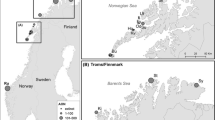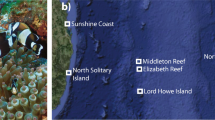Abstract
Out of more than 380 species of damselfish, only three lack a pelagic larval phase, Acanthochromis polyacanthus, that ranges from the Philippines to the Great Barrier Reef, and two species in the genus Altrichthys, A. azurelineatus and A. curatus, that are restricted to the Calamian Archipelago (Palawan province) in the Philippines. Therefore in a very restricted geographic area, northern Palawan, Philippines, all three species co-occur. The goal of this study was to fill a knowledge gap about the ecology of Altrichthys, where very little is currently known. Using census and behavioral approaches at 14 sites on six islands, we were able to identify adult densities, nest densities, nesting habitat preference, and brood behavior and abundance. We found that densities were very high (more than 17 individuals/100 m2 for one species) and A. azurelineatus may be displacing A. curatus at deeper depths where habitat seems of higher quality. Only one out of 14 surveyed sites contained only one species, Altrichthys curatus. Different habitat use and feeding behavior suggest that niche partitioning may play an important role in the life history of these sympatric species.


Similar content being viewed by others
References
Albertson RC (2008) Morphological divergence predicts habitat partitioning in a Lake Malawi cichlid species complex. Copeia 2008:689–698
Allen GR (1999) Altrichthys, a new genus of damselfish (Pomacentridae) from Philippine seas with description of a new species. Rev Fr d’ Aquariol 26:23–28
Barlow GW (1981) Patterns of parental investment, dispersal and size among coral-reef fishes. Environ Biol Fish 6:65–85
Bernardi G (2011) Monophyletic origin of brood care in damselfishes. Mol Phylogenet Evol 59:245–248
Buckley J, Maunder RJ, Foey A et al (2010) Biparental mucus feeding: a unique example of parental care in an Amazonian cichlid. J Exp Biol 213:3787–3795
Cooper WJ, Smith LL, Westneat MW (2009) Exploring the radiation of a diverse reef fish family: phylogenetics of the damselfishes (Pomacentridae), with new classifications based on molecular analyses of all genera. Mol Phylogenet Evol 52:1–16
Doherty PJ, Planes S, Mather P (1995) Gene flow and larval duration in seven species of fish from the great barrier reef. Ecology 76:2373–2391
Frédérich B, Parmentier E (2016) Biology of damselfishes. CRC Press, Boca Raton
Jan RQ (1997) Sympatric spawning of the damselfishes Chromis fumea and Pomacentrus coelestis on the northern coast of Taiwan. Zool Stud 36:26–32
Jan RQ (2000) Resource limitation underlying reproductive strategies of coral reef fishes: a hypothesis. Zool Stud 39:266–274
Leis JM (1991) The pelagic stage of reef fishes. In: Sale P (ed) Ecol. Fishes coral reefs. Academic Press Inc., San Diego, CA, pp. 182–229
Munday PL (2004) Competitive coexistence of coral-dwelling fishes: the lottery hypothesis revisited. Ecology 85:623–628
Noakes DLG (1979) Parent-touching behavior by young fishes: incidence, function and causation. Environ Biol Fish 4:389–400
Planes S, Doherty PJ, Bernardi G (2001) Strong genetic divergence among populations of a marine fish with limited dispersal, Acanthochromis polyacanthus, within the great barrier reef and the Coral Sea. Evolution (N Y) 55:2263–2273
Ree RH, Smith SA (2008) Maximum likelihood inference of geographic range evolution by dispersal, local extinction, and cladogenesis. Syst Biol 57:4–14. doi:10.1080/10635150701883881
Robertson DR (1973) Field observations on the reproductive behaviour of a pomacentrid fish, Acanthochromis polyacanthus. Z Tierpsychol 32:319–324
Robertson DR, Lassig B (1980) Spatial distribution patterns and damselfishes from the great barrier reef. Bull Mar Sci 30:187–203
Sale PF (1977) Maintenance of high diversity in coral reef fish communities. Am Nat 111:337–359
Sale PF (1978) Coexistence of coral reef fishes - a lottery for living space. Environ Biol Fish 3:85–102
Sale PF (1991) Reef fish communities: open nonequilibrial systems. In: Sale PF (ed) Ecol. Fishes coral reefs. Academic Press, New York, pp. 564–598
Sale PF, Dybdahl R (1975) Determinants of community structure for coral reef fishes in an experimental habitat. Ecology 56:1343–1355
Shpigel M, Fishelson L (1989) Habitat partitioning between species of the genus Cephalopholis (Pisces, Serranidae) across the fringing reef of the Gulf of Aqaba (Red Sea). Mar Ecol Prog Ser 58:17–22
Taborsky M (1984) Broodcare helpers in the cichlid fish Lamprologus brichardi: their costs and benefits. Anim Behav 32:1236–1252
Thresher RE (1985) Distribution, abundance, and reproductive success in the coral reef fish Acanthochromis polyacanthus. Ecology 1985:1139–1150
Vagelli A (1999) The reproductive biology and early ontogeny of the mouthbrooding Banggai cardinalfish, Pterapogon kauderni (Perciformes, Apogonidae). Environ Biol Fish 56:79–92
Vagelli A, Burford M, Bernardi G (2009) Fine scale dispersal in Banggai cardinalfish, Pterapogon kauderni, a coral reef species lacking a pelagic larval phase. Mar Genomics 1:129–134. doi:10.1016/j.margen.2009.01.001
van Herwerden L, Doherty PJ (2006) Contrasting genetic structures across two hybrid zones of a tropical reef fish, Acanthochromis polyacanthus (Bleeker 1855). J Evol Biol 19:239–252. doi:10.1111/j.1420-9101.2005.00969.x
Waldner RE, Robertson DR (1980) Patterns of habitat partitioning by eight species of territorial Caribbean damslefishes (Pisces: Pomacentridae). Bull Mar Sci 30:171–186
Welsh SA, Perry SA (1998) Habitat partitioning in a community of darters in the Elk River, West Virginia. Environ Biol Fish 51:411–419
Acknowledgements
We would like to thank Avigdor Abelson and Gustav Paulay for help in coral identification. We would like to thank Amalia Bernardi and Alessio Bernardi for help in the field, and the staff of Dive Link Resort, Uson Island, for logistical support. This study followed Animal Care protocols (UC CARC approval BERNG1601). This work was funded by a National Geographic Grant and a COR grant from UCSC to GB.
Author information
Authors and Affiliations
Corresponding author
Rights and permissions
About this article
Cite this article
Bernardi, G., Crane, N.L., Longo, G.C. et al. The ecology of Altrichthys azurelineatus and A. curatus, two damselfishes that lack a pelagic larval phase. Environ Biol Fish 100, 111–120 (2017). https://doi.org/10.1007/s10641-016-0559-9
Received:
Accepted:
Published:
Issue Date:
DOI: https://doi.org/10.1007/s10641-016-0559-9




